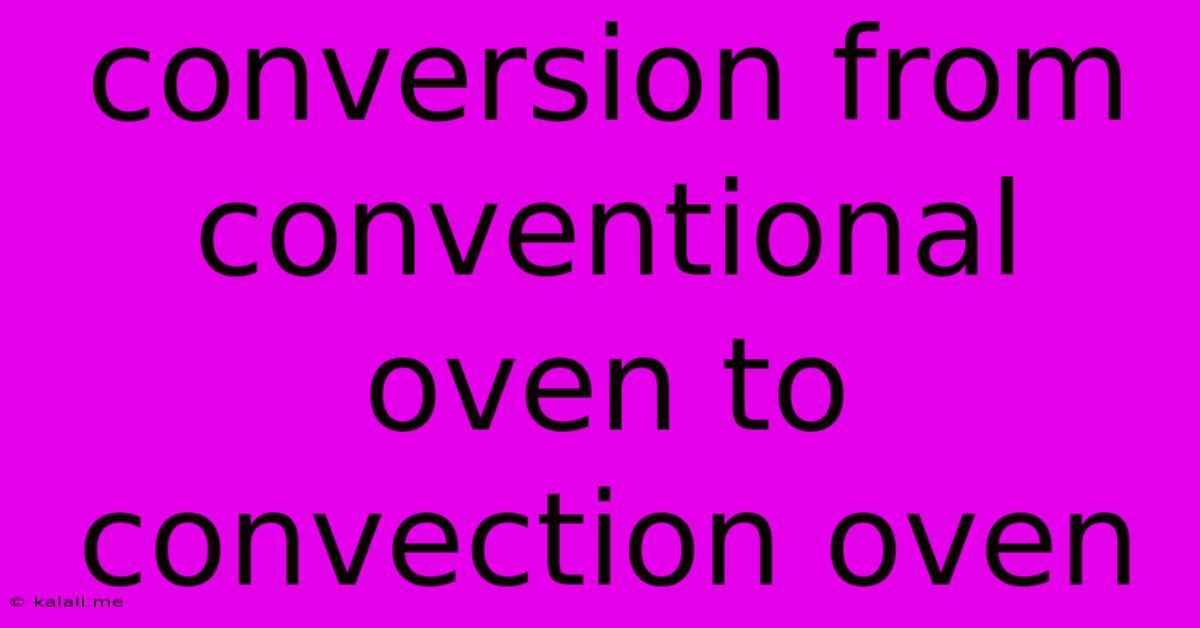Conversion From Conventional Oven To Convection Oven
Kalali
Jun 03, 2025 · 3 min read

Table of Contents
Mastering the Conversion: Conventional Oven to Convection Oven
Meta Description: Learn how to successfully convert your conventional oven recipes to convection, avoiding common pitfalls and achieving perfectly cooked results every time. This guide covers temperature adjustments, cooking time modifications, and tips for various dishes.
Switching from a conventional oven to a convection oven can feel like learning to cook all over again. Convection ovens utilize a fan to circulate hot air, resulting in faster and more even cooking. While this is a significant advantage, it also requires adjustments to your existing recipes. This comprehensive guide will teach you how to flawlessly convert your favorite conventional oven recipes to their convection counterparts.
Understanding the Differences: Conventional vs. Convection
Before diving into conversions, it's crucial to grasp the fundamental difference. A conventional oven heats the air from the bottom and top elements, leading to uneven heat distribution. This often necessitates rotating dishes mid-bake. A convection oven, on the other hand, uses a fan to circulate the hot air, ensuring consistent heat throughout the oven cavity. This even heat distribution results in faster cooking times and crispier results.
The Key to Successful Conversion: Temperature and Time
The most critical aspect of converting recipes is adjusting the temperature and cooking time. Generally, you'll need to reduce the temperature by 25°F (14°C) and reduce the cooking time by 25%. However, this is a guideline, and the specific adjustments will depend on your oven, the recipe, and the food being cooked.
-
Temperature: The circulating hot air in a convection oven cooks food faster, hence the lower temperature setting prevents overcooking.
-
Time: The even heat distribution speeds up the cooking process, resulting in shorter cooking times. Closely monitor your food during the first few convection cooks to learn your oven’s specific behavior.
Recipe Conversion: A Step-by-Step Guide
Here's a practical approach to converting your recipes:
-
Start with a familiar recipe: Choose a recipe you've made many times in your conventional oven, ensuring you're comfortable with the results.
-
Adjust the temperature: Lower the temperature by 25°F (14°C). For example, if your conventional recipe calls for 350°F (175°C), set your convection oven to 325°F (163°C).
-
Reduce the cooking time: Decrease the cooking time by 25%. If the recipe suggests 30 minutes, try 22-23 minutes.
-
Monitor closely: Keep a close eye on your food throughout the cooking process. Use a meat thermometer for meats to ensure they reach the safe internal temperature.
-
Adjust as needed: Don't be afraid to make further adjustments based on your observations. Every oven is slightly different, so fine-tuning is essential.
-
Document your findings: Keep notes on the adjustments you made to each recipe. This will help you refine your conversion technique over time.
Specific Considerations for Different Dishes:
-
Baking: Cakes, cookies, and pastries often benefit from the even heat of a convection oven. Remember to reduce the temperature and time, and check for doneness using a toothpick or cake tester.
-
Roasting: Roasting vegetables and meats in a convection oven results in crispier exteriors and evenly cooked interiors. Use a meat thermometer to check for doneness and adjust accordingly.
-
Broiling: Convection ovens can also broil, but the higher heat and faster cooking times might require shorter broiling times.
Troubleshooting Common Issues:
-
Overcooked food: If your food is overcooked, reduce the temperature further for future attempts.
-
Undercooked food: If your food is undercooked, slightly increase the cooking time or temperature for future attempts.
-
Uneven browning: While convection ovens provide even heat, slight adjustments may be needed for specific recipes. Consider rotating pans or adjusting rack positions to address any browning inconsistencies.
By following these guidelines and paying close attention to your oven and the food you're cooking, you'll master the art of converting your conventional oven recipes to your convection oven, unlocking a world of perfectly cooked meals. Remember, practice makes perfect!
Latest Posts
Latest Posts
-
Pro Tools Automition Track Shortcut Key
Jun 05, 2025
-
Can My Computer Play This Game
Jun 05, 2025
-
Why Roc Curve For Breast Cancer Has Only 1 Corner
Jun 05, 2025
-
Python Linear Programming Region Of Every Variable
Jun 05, 2025
-
Alpha Configuration Bonded To Beta Configuration
Jun 05, 2025
Related Post
Thank you for visiting our website which covers about Conversion From Conventional Oven To Convection Oven . We hope the information provided has been useful to you. Feel free to contact us if you have any questions or need further assistance. See you next time and don't miss to bookmark.